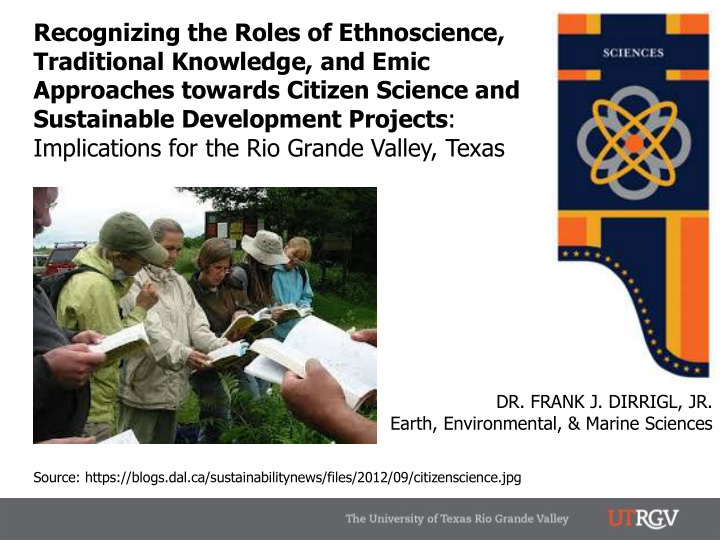



Recognizing the Roles of Ethnoscience, Traditional Knowledge, and Emic Approaches towards Citizen Science and Sustainable Development Projects : Implications for the Rio Grande Valley, Texas DR. FRANK J. DIRRIGL, JR. Earth, Environmental, & Marine Sciences Source: https://blogs.dal.ca/sustainabilitynews/files/2012/09/citizenscience.jpg
The Three Pillars “Development that meets the needs of the present without compromising the ability of future generations to meet their own needs” (World Commission on Environment and Development, 1987), Sources: eoearth.org; Office of the President, General Assembly of the United Nations;
The Fourth Pillar Engagement Belief & Meaning UN Global Compact Cities Programme
Ethnoscience, the Tenejapa Ladino, and Tzeltal [Mayan] Metzger & Williams 1963, American Anthropologist; 1966, American Anthropologist Sources: www.sancristoballanguageschool.org; http://ranchero963.blogspot.com
Firewood Western Example Tzetal Example Sources: Metzger & Williams 1966, American Anthropologist; http://i.imgur.com/IYtqLd7.jpg
Ethnozoology Source: http://trabajosocialchiapasegrets.blogspot.com/
Traditional Knowledge “ The indigenous people of the world possess an immense knowledge of their environments, based on centuries of living close to nature. Living in and from the richness and variety of complex ecosystems, they have an understanding of the properties of plants and animals, the functioning of ecosystems and the techniques for using and managing them that is particular and often detailed. In rural communities in developing countries, locally occurring species are relied on for many - sometimes all - foods, medicines, fuel, building materials and other products. Equally, people’s knowledge and perceptions of the environment, and their relationships with it, are often important elements of cultural identity. Source: The Director General of United Nations Educational, Scientific and Cultural Organization (Mayor, 1994); www.nativescience.org
Native & Community Citizen Science Source: Science 06/05/2015
Source: Haklay 2013, Citizen Science and Volunteered Geographic Information – overview and typology of participation
Common Survey Source: Gowda & Nayak 2014, Int J Med Public Health
Semi-Structured Interviews: Togo People Source: Spuhler 2007; countryreports.org
Rio Grande Valley: Medical Anthropology Source: Dirrigl & Vitek 2013, The Applied Anthropologist
Personify & Humanize Source: Dirrigl & Vitek 2013, The Applied Anthropologist
Emic Approach Etic Emic
Source: http://www.nativescience.org
Colonias Source: http://urbanedge.blogs.rice.edu; lubbockonline. Com;
Colonias • 500,000 Texans • 73% American Citizens - 100 • Mexican-American • 2, 200 Colonias • 3x National Poverty Level Source: http://urbanedge.blogs.rice.edu
• Potable Water • Legal Plats • Drainage Source: http://urbanedge.blogs.rice.edu; www.srh.noaa.gov/
Source: quod.lib.umich.edu
Source: themonitor.com
• Potable Water • Legal Plats • Drainage Source: quod.lib.umich.edu
Source: quod.lib.umich.edu
Citizen Science & Monitoring • Water Quality Sampling • Field Ovipositioning Trapping • Personal Observations & Landing Rates Source: earthwatch.org; devcomconvergence.wordpress.com; www.myhorrynews.com
Citizen Science & Monitoring • Post-Flooding Nuisance Species • Disease Vector Species • Laboratory Mosquito Rearing with Flood Waters Source: http://ecdc.europa.eu/EN/HEALTHTOPICS/DENGUE_FEVER; billclarkbugsperts.com; www.flickr.com
Source: https://sustainabledevelopment.un.org
Source: https://sustainabledevelopment.un.org
Water Place Settlements UN Global Compact Cities Programme
Source: www.loyno.edu
Questions ?
Recommend
More recommend